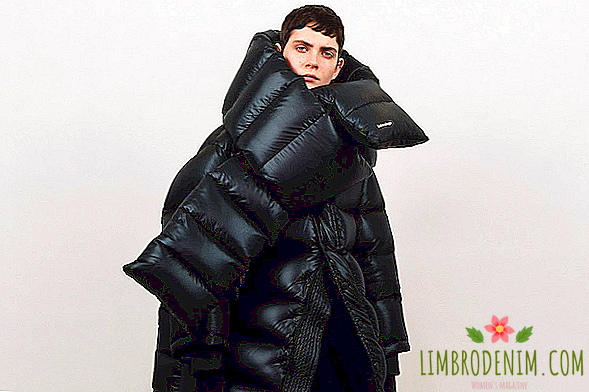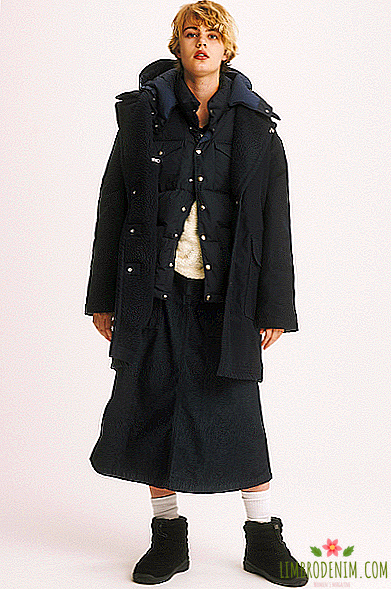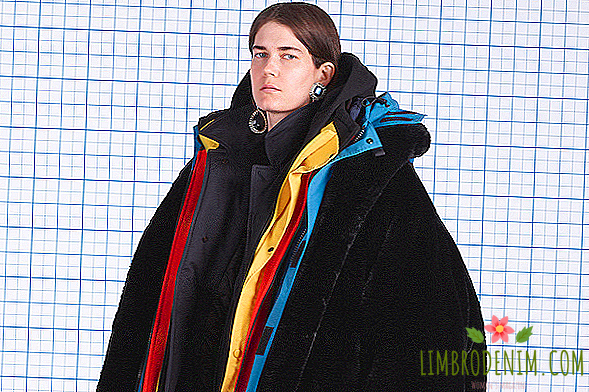Do not sweat or freeze: How to dress in winter correctly
Winter is not the easiest time to realize fashionable ambitions. Down jackets, voluminous sweaters and thermal underwear become the main things in the wardrobe for several months. Fortunately, designers have long learned to do warm and nice things for the most cold. We learned how to dress in order to feel comfortable in minus temperatures, for those who spend a lot of time outside.
Text: Anya Krotikova

Ksenia Afanasyev
organizer of the Moscow Marathon
 I prefer to dress in layers. When it is completely cold, I can wear as many as five: thermal underwear, a thin sweater, slim with a zipper, a thin waistcoat with a feather - and a winter jacket on top. The practice of wearing a thin down jacket under outerwear is generally the favorite life hacking of those who wear coats in winter. My coat is cold, so I wear a down jacket under a down jacket. The main thing is that there is air between the layers - otherwise the magic will not work. With shoes all the same. I was always cold in good winter shoes with fur, put on a sock, until I realized that if my foot was tight, then she would definitely be cold. Now I wear Native shoes, they don’t have any insulation at all, but a very comfortable shoe: a wide nose, there is space inside, and they don’t "walk." I can wear a warm sock, but my fingers are not immobilized.
I prefer to dress in layers. When it is completely cold, I can wear as many as five: thermal underwear, a thin sweater, slim with a zipper, a thin waistcoat with a feather - and a winter jacket on top. The practice of wearing a thin down jacket under outerwear is generally the favorite life hacking of those who wear coats in winter. My coat is cold, so I wear a down jacket under a down jacket. The main thing is that there is air between the layers - otherwise the magic will not work. With shoes all the same. I was always cold in good winter shoes with fur, put on a sock, until I realized that if my foot was tight, then she would definitely be cold. Now I wear Native shoes, they don’t have any insulation at all, but a very comfortable shoe: a wide nose, there is space inside, and they don’t "walk." I can wear a warm sock, but my fingers are not immobilized.
And for long and short walks I dress about the same. I like to be ready for anything. If my husband and I are going to walk the dog for a long time, then I put on more layers and prefer high-tech sportswear. Personally, I am saved by a combination of synthetic materials, natural wool and things for down. Say, good winter thermal underwear with a pile, a thin sweater on top, a thin down vest plus a winter down jacket.
I love to go to the coat and respect those who can not afford to dress in jackets for the winter. I can not - I'm cold. Recently watched a classroom webinar on the theme of winter wardrobe. Every second picture is not about my case: bare ankles, light shoes, open coats, carelessly thrown over scarves. She recommended wearing Uniqlo light down jackets as a warm lining. But for me it works exactly to zero degrees. In a minus I carry a volume long down-padded coat and I advise all.
How we transfer the cold is influenced not only by the thermometer, but also by other factors: humidity, wind direction and speed. I focus on applications that show not only the temperature, but also the real feel - that is, how this temperature is felt. It happens that the thermometer is minus seven, and they are felt like minus eighteen. On such days, I definitely will not wear nylon panty hoses even under a long down jacket.


Vladimir Ivshin
Independent outdoor expert and member of the MHAK's mountaineering team
 There is such a climbing joke: "Going to the mountains is a process of continuous dressing and undressing." The idea is that the weather during the day can change, and therefore it is important to be prepared for everything, because overheating and hypothermia entail unpleasant consequences. The principle of layering is universal, especially since the temperature in the city changes at least as much as in the mountains: every now and then we go to the subway, cafes, offices. It would be nice to plan how you will lay up your clothes in advance, so that you will understand how you will wear it all at the purchase stage.
There is such a climbing joke: "Going to the mountains is a process of continuous dressing and undressing." The idea is that the weather during the day can change, and therefore it is important to be prepared for everything, because overheating and hypothermia entail unpleasant consequences. The principle of layering is universal, especially since the temperature in the city changes at least as much as in the mountains: every now and then we go to the subway, cafes, offices. It would be nice to plan how you will lay up your clothes in advance, so that you will understand how you will wear it all at the purchase stage.
In my opinion, there are two approaches to how to warm themselves properly during the cold season. The first is to keep several jackets in the closet for different weather conditions, from a thin liner to a thick coat, and choose the right thing (or combination of things) depending on the weather (for example, a thin undercoat with an average powder puff). The second is to buy one super warm model and, in the case of a small minus, wear it directly on a shirt or T-shirt. Accessories - required. The lack of adequate caps, mittens and weather-ineliented shoes will take away about 20% of the heat generated by your body. I am glad that balaclava is gaining popularity - they replace a scarf and a hat at once.
When choosing outerwear for the winter, first of all, you need to pay attention to the quantity and quality of insulation and remember that there are no miracles. Fill Power is an index of the density and overall quality of the down, which shows to what volume the down is able to recover after compression and how much air the down and feather mixture used in the product can hold. So, a thin padded jacket with a premium down of 900 FP will not save even at minus ten - it is needed as a liner or for short overruns. Conversely, a fat duktik with regular down 550-600 FP will allow you to walk to minus twenty (and a jacket with a down of better quality of the same thickness will be even warmer and lighter). PrimaLoft perfectly shows itself as a synthetic filler.
Different outdoor technologies and materials work coolly, since the range of many outdoor brands includes things that look organic in the city. If we talk about the middle layers, then I definitely recommend fleece models of any thickness. Now, for example, there were just wonderful "furry" sweaters in Uniqlo. If we talk about pants, then we can consider options from high-tech, such as softshell, or combined fabrics - brands Arc'teryx, The North Face, Patagonia, Fjällräven, Norrøna offer a good choice. Fleece pants will do.
When going outside you need to consider how actively you will move and how much time you plan to spend in the cold. If you have an optimized route home - work - home, you live near the subway, check in advance the arrival of buses on the application, then you can get dressed a little easier put on the thermometer. For any long walk without planned activities, it is best to dress in strict accordance with a street thermometer - it can be even a little warmer.
Each person has his own temperature comfort. The easiest way to build on the average temperature minimum for the season for the region, but taking into account cold snap. For example, in Moscow, the average temperature for the segment November - March is about minus eight degrees, but not uncommon and frost under minus twenty. Given these data, I would choose a free warm jacket, under which in the case of a cold snap, you could fasten something else. As for shoes, in principle, Moscow allows you to go through the whole season in demi-season sneakers with a stable tread and good, preferably specialized, socks. I myself wear “ugly” trekking Salomon Quest 4D boots without warming, but with “gortex” - I have an extensive fleet of hiking socks, so if it's completely cold or, say, I go to the forest, I just wear something thicker.
The time of nightmares and underpants is over. Now the underwear looks so modern and cool that you can wear it for reasons of not only comfort, but also style. For many years I have been following the rule based on army experience: on October 15, I switch to winter uniform, that is, I start wearing thermal underwear, and on April 15, I stop. Moreover, due to effective heat preservation, thermal underwear allows you to put on lighter upper things. And if the set is balanced, then it can be quite comfortable to spend the whole day indoors.

Anna Rameeva
physician therapist clinic "Dawn"
 The choice of clothing in cold weather should be determined by comfort and safety. Since we are warm-blooded and all our vital biochemical reactions depend on the temperature of the "core" of our body, then, whether we like it or not, the body will maintain its 35.5-38 degrees. To help him do it with minimal cost is our goal at any time of the year.
The choice of clothing in cold weather should be determined by comfort and safety. Since we are warm-blooded and all our vital biochemical reactions depend on the temperature of the "core" of our body, then, whether we like it or not, the body will maintain its 35.5-38 degrees. To help him do it with minimal cost is our goal at any time of the year.
Difficulties in the correct selection of winter clothing in the city are mainly associated with uneven conditions of movement to work. The stay in the car, public transport alternates with rushes of different duration and intensity along the winter streets. It is unlikely that it will be possible to formulate universal recommendations, as people suffer from cold in different ways.
Women more easily retain the internal temperature of the body, because by nature they have a more uniform distribution of subcutaneous fat, but they are more susceptible to excessive cooling of the feet, hands, face. Heat transfer also depends on the natural metabolic rate, on how much you slept, whether food intake was sufficient, and what state your hormonal and nervous system is in. We must not forget about the adaptation of the organism: a person who grew up in a warm climate needs time to give up two pairs of wool socks in the conditions of northern winter.
Despite individual requirements, the tasks will be the same: the shoes must be free and waterproof, the sole should be non-slip, and the clothes should be multi-layered and warm. Gloves, mittens and a headdress are necessary and very effective elements of the wardrobe; they should not be neglected. They did not sweat, did not freeze and did not fall - the main indicators of the correct choice.
Let us dwell on the principle of layering clothes. The most detailed this issue is covered in terms of comfortable workouts in the cold season, travel, physical work outdoors in the winter. The principle itself is based on the use of several layers of clothing from different fabrics, each of which performs a strictly defined function. The layer closest to the skin should remove sweat and moisture from the body. For this purpose, different types of thermal underwear made of fine merino wool, polyester and microfiber polyester fabrics have been developed. The middle layer should isolate from the cold. As a rule, it is down, synthetic winterizer or fleece. The outer layer should protect from wind and water. Dry warm air between the layers also acts as insulation, reducing heat loss.
A “sandwich” made of relatively thin and light technological fabrics will help out if you are moving intensively on the way to the office and the temperature on the street is not lower than minus ten. If this part of the way you spend in the subway, the use of thermal underwear, perhaps, becomes the best means of regulating sweating in conditions of sudden changes in temperature. The more you plan to move, the higher should be the content of synthetics in the base layer. Avoid tight-fitting stretch and lycra models, as they dry longer and are not comfortable with long wearing.
If you have an unpredictable long wait for transport at the bus stop or today is the right day for a measured walk through the winter park, then, regardless of the numbers on the thermometer, wear the most warmth. Increase the number of layers - there should be at least three of them. Use woolen knitted and fleece things, hats, scarves and down jackets. It is impossible to overheat in the open air in frosty weather. In ground transportation, take off your hat and mittens, on the subway, in addition, be sure to remove your jacket or coat, unbutton your jacket or jacket.
If you are traveling by car, then do not be zealous with the heating of the cabin. Let the car be cool. Overheating is no less harmful than hypothermia. At the same time, we lose water and electrolytes - this reduces the performance of the body, makes us sluggish, scattered, and in predisposed persons creates conditions for the onset of venous thrombosis and urolithiasis. In addition, excessive sweating is not hygienic and can contribute to maceration and fungal infections.
Two serious factors affect our skin in winter: cold and lack of moisture in the air. Long stay in moderate frost or extremely low temperature in itself creates the prerequisites for frostbite of open areas of the body and peripheral tissues. The ears, chin, lips, tips of the fingers, toes, and the tip of the nose become the most vulnerable in cold conditions. Temperatures above zero and dampness with prolonged exposure can also cause skin damage: perniosis, or chill, the appearance of dense bluish swellings of various sizes, painful and itchy, on the skin of the cheeks, hands, legs, buttocks. Most often this phenomenon is observed in adolescents and young women and is associated with inflammation of the small vessels of the skin and circulatory disorders in the skin when exposed to cold. Redness, peeling of open skin, accompanied by itching, may be the result of contact cold dermatitis. All these skin changes are exacerbated by exposure to dry air, which is characteristic of sub-zero temperatures. The loss of moisture contributes to the appearance of painful cracks, making the skin more vulnerable to infections.
Another adverse factor that lurks us in a snowy winter can be intense ultraviolet irradiation when skiing and snowboarding. The risk of sunburn in this case is high, because ultraviolet light is increased several times, reflected from the snow.
Thus, in winter, leather requires additional protection and care. First, cover-close-hide. Hats, mittens and scarves are invented not only for children. If clothes become wet, change clothes as soon as possible. Secondly, it is necessary to moisturize the skin every day: after water procedures and several times during the day. 15-20 minutes before going outside, open skin should be smeared with a special protective agent with a minimum water content. If you have to conquer the mountain peaks, do not forget that the cream must have a high degree of ultraviolet protection with an SPF of at least 30.
Frost and dry air are not safe for hair. In winter, the amount of dandruff increases, the hair quickly loses its freshness, becomes brittle, electrifies greatly. Intensive moisture loss can be compensated by refusing daily washing of the head and using a hair dryer, forceps and styling irons. If possible, wash your hair 2-3 times a week with a moisturizing shampoo and dry your hair naturally. If you need to use a hair dryer, turn on low and medium modes of operation. Use wooden and ceramic hairbrushes.
As for hypothermia and disease. The common cold, in the classical sense, develops as a result of ingestion of a pathogenic bacterium, and more often of a virus. If choosing a yogurt in a store on the way home, you caught the flu virus, then you are frozen today or not, it does not matter - alas, you will have to take sick leave. If the causative agent of a viral infection is, but it is not too aggressive, and the immune system works like a clock (this is how it works for most of us), then the body can cope with it without your knowledge, regardless of the temperature outside the window. But if you are experiencing severe emotional stress, do not sleep for several days, you have long hungry intervals, there is little protein in the diet, or you suffer from a serious chronic illness, then high energy costs for warming the body may not leave a reserve for adequate immune system and then "all secret becomes apparent."
Photo: totokaelo, acnestudios, balenciaga, nanamica




